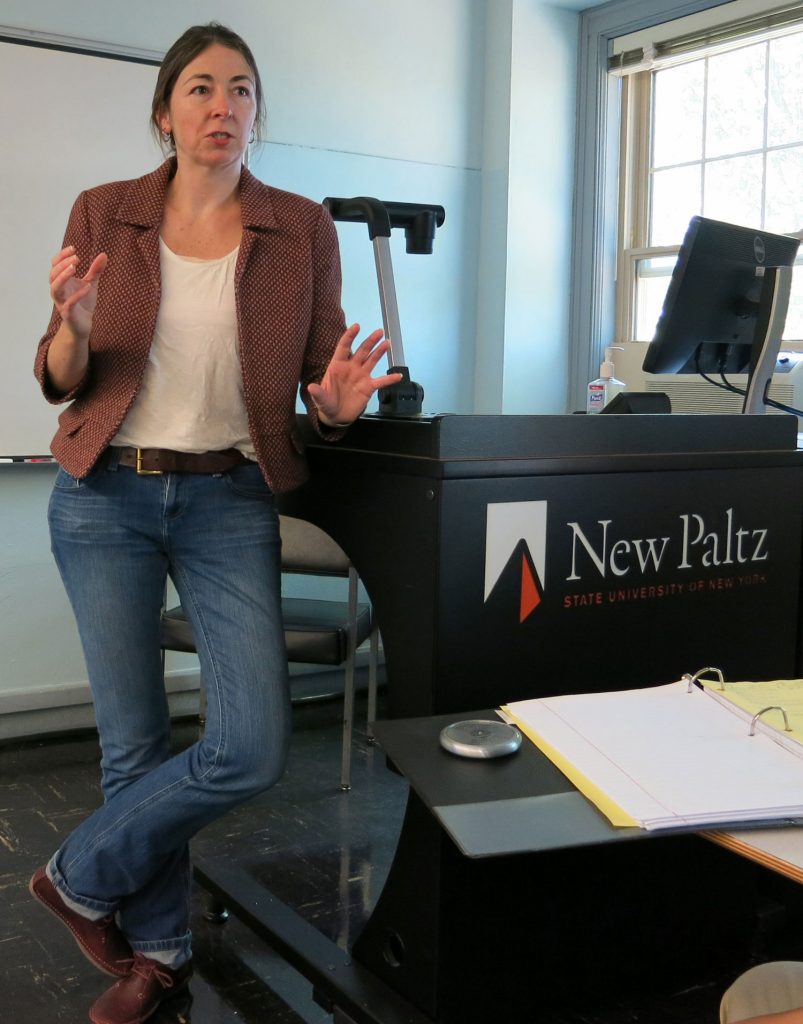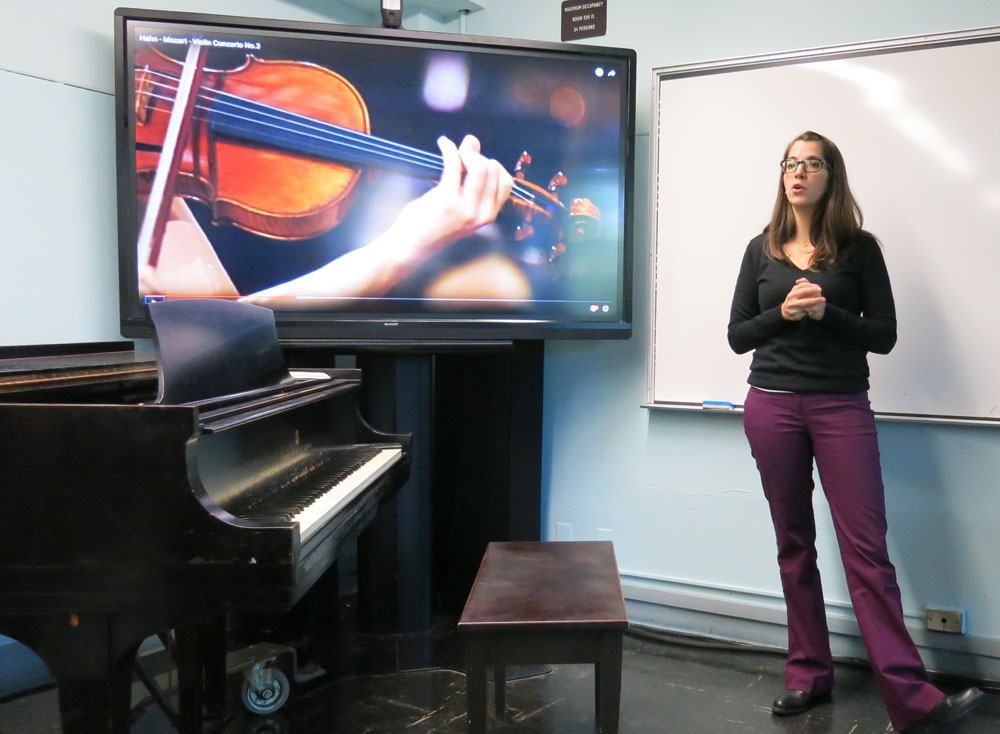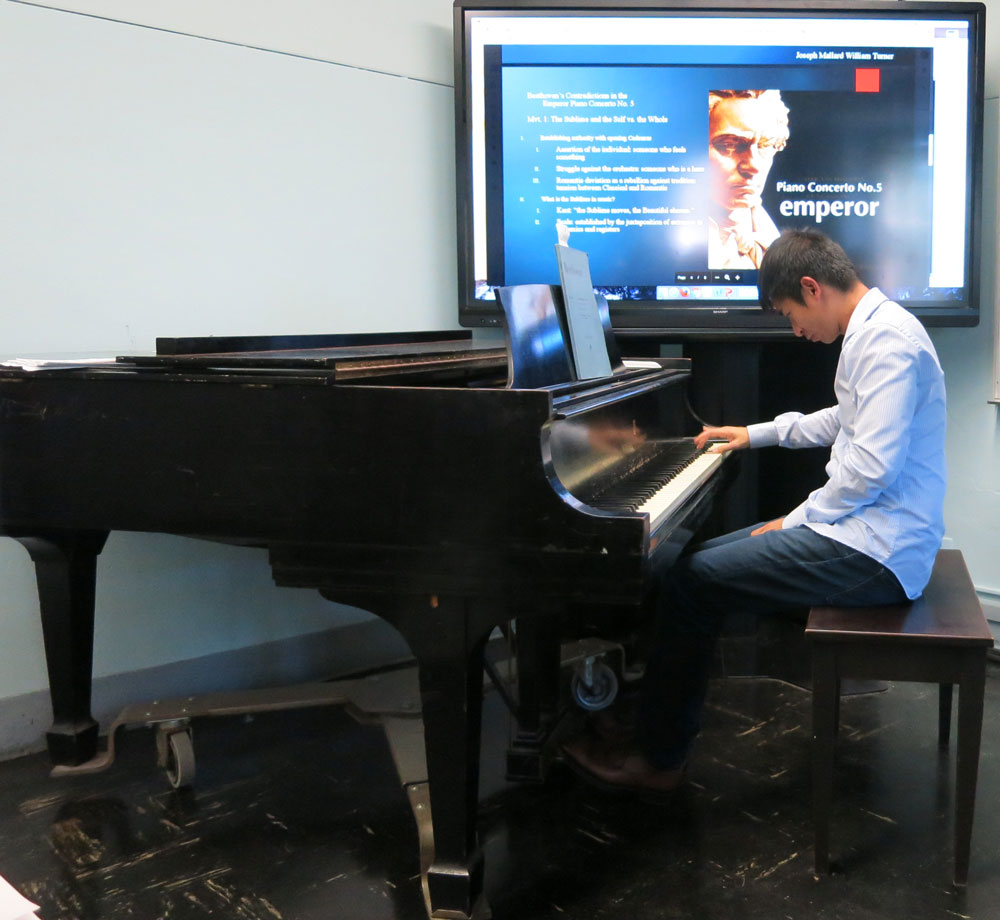Interdisciplinary Beethoven Lecture Explores the Sublime in Music
Heather Morrison, associate professor of history, had a modest objective for her fall “Youth Culture in Europe” lecture on Romantic composer Ludwig van Beethoven.
She hoped the sublime effects of Beethoven’s music would encircle her students in bright rings of light, inflame their imaginations, their innermost souls, and bear them speeding on the wing into the far-off spirit realm of music.
To accomplish this, she’d assign German Romantic composer and writer Ernst Theodor Amadeus Hoffman’s 1813 piece “Beethoven’s Instrumental Music,” from which that previous sentence was adapted, to locate the composer’s work within the Romantic tradition.
Her students also would read Immanuel Kant’s iconic 1764 work “The Beautiful and Sublime,” to discover an important distinction between man’s finer feelings: “The sublime moves, the beautiful charms.”
But in order to truly inflame their young imaginations, Morrison needed to call in a favor.
Though she’s published on the freemasonic drinking songs associated with Wolfgang Amadeus Mozart, Morrison always regretted not being a more informed listener of classical music. When she discovered that Alex Pex, assistant professor of music, was performing an October Beethoven Concert as part of the Studley Theater Concert Series, Morrison knew the timing was perfect for an interdisciplinary collaboration.

In structuring her freshman course, Morrison wanted her students to explore their personal connections to the material and cultivate personal reactions. The Beethoven concert presented Morrison a unique opportunity to show her students how youth in late 18th-century Vienna rejected the Enlightenment’s rational framework in favor of the more creative and individualistic expressions of 19th-century Romanticism, a struggle immortalized in Beethoven’s music.
“The Romantic era seemed like a perfect way to get students to think about how their own desires for exploring and understanding themselves at this stage of their life drove people their age two hundred years ago, too,” Morrison said.
In preparing his presentation, Peh called on the help of new music colleague Christiana Fortune Reader, who has a strong background in German Romantic musicology, and the three made a date in College Hall on October 2, in a classroom outfitted with a piano.
What followed could only be described as a teaching tour de force, with Morrison, Peh and Reader seamlessly transitioning from an historical account of the Enlightenment and Romantic eras to the music it inspired – punctuated throughout by Peh’s brilliant piano playing.
Morrison set the stage by describing the Enlightenment ideas of equality, unity and harmony that enchanted those living and working in late 18th-century Vienna, including Mozart, who composed music under the patronage of the imperial court.
Describing how Mozart’s compositions reflected the Enlightenment’s embrace of the classical forms of symmetry and balance, Reader likened the concerto structure (exposition, development and cadenza), to the three parts of an essay—the introduction, body and conclusion.
“It was just like what you learned in these intro to writing classes—you should have a beginning, a middle and an end,” noted Reader. “In the beginning, we present our ideas, in the middle we discuss the ideas, and at the end, we bring them all together with one beautifully drawn conclusion. Mozart wanted us to hear that in music.”
Beethoven and Romanticism
Beethoven encountered a very different Vienna upon moving to the city just after Mozart’s death. Morrison described how a city that had been so inspired by the possibility of liberty and equality had become disillusioned by the French Revolution and execution of 40,000 political dissidents during the Reign of Terror.
The Romantic reaction to the French revolution was, Morrison noted, not only a continued desire for the ideals of liberty espoused by Napoleon Bonaparte, but also a sense of regret for the revolution’s violence and a concern for the sudden break from the past and traditions that it fostered.
Whereas the Enlightenment emphasized broad progress for humanity, Romanticism focused on exploring one’s inner self and becoming harmonious with an “awe-inspiring, greater totality,” which came in a variety of forms—man’s connection to nature, nation, God, or a more secular understanding of the cosmos.
Romantics sought to experience the sublime, which Kant described as arousing “enjoyment, but with horror” through the arts by exploring dialectics, paradoxes and contradictions.
As Romanticism emphasized individual genius over collective good, Beethoven emerged as a figure of mythic proportions. Hoffman called him a “purely Romantic composer” whose music set into motion “the machinery of awe, of fear, of terror, of pain, and awakens that infinite yearning which is the essence of Romanticism.”

As Morrison set the stage for Beethoven’s prominence as a Romantic figure, Peh and Reader discussed how Beethoven’s music transgressed the concerto structure made famous by Mozart.
Showing a clip from the first movement in an orchestral performance of Beethoven’s Emperor Concerto, Peh and Reader noted how Beethoven broke from the concerto’s classic structure by having the soloist, rather than the orchestra, exert his authority at the very beginning.
“It sets up a struggle between personal, individual freedom—my desire to make my own cadenza. The conductor is watching the soloist play freely, and the orchestra is going to try to reassert its control, and Beethoven the soloist is going to have none of that,” said Peh.
In the final movement, Beethoven brings together the soloist and orchestra in unity, which signifies the individual brought back into a universal whole. “If we think about this in terms of establishing authority, it’s the assertion of the individual, the struggle against a larger whole, and then reintegration,” noted Reader. “Someone is a hero, but still part of society, and that is representative of a Romantic rebellion against tradition.”
Experiencing the Sublime
Beyond giving Morrison’s students an illuminating introduction to music appreciation, Peh and Reader sought to demonstrate the sublime in Beethoven’s music, which the composer established through a juxtaposition of extremes.
As Peh played excerpts from the concerto’s second theme, with its wild variations in register, dynamic and character, Reader asked students to call out adjectives that described the mood of Beethoven’s work, which varied from “maniacal, angry, frightful, thunderous” to “thoughtful, reflective, gentle, mysterious” to “hopeful and introspective.”
“It gives you a dizzying feeling, that feeling of awe,” noted Peh. “That is the sublime in music. Beethoven’s trying to create the world for you here.”

The students received free tickets to Peh’s Beethoven concert the following evening. The class concluded with Morrison’s instruction to “drop your modern day cynicism and put yourself in the mental universe of a Romantic era youth.”
Morrison hoped her students would experience the sublime in music and cultivate their inward self-reflection, which she felt her colleagues’ virtuoso performance better equipped them to accomplish.
“I knew if I just gave them a lecture that defined Romanticism, only one or two of the students might feel or think about that connection to their personal self-development,” said Morrison, adding, “The success of this whole experiment depended on Christiana’s and Alex’s work to get them to go into that concert interested in and able to open themselves up to an experience like that.”
Reflecting on the interdisciplinary lecture, student Becky Ptacek ’21 (Communication Disorders) said, “Before this class, my understanding of Romanticism was stereotypical; it was an era of love and romance.” After the lecture, she discovered that the era was more focused on the self than she’d originally thought. “It was about self-reflection and self-development, which is beautifully portrayed in Beethoven’s work.”
Ptacek described Peh’s evening concert as “incredible,” and said the lecture helped her to appreciate Beethoven’s work and enjoy a moving concert experience.
Like a true Romantic, Ptacek connected the performance to her personal journey as a young college student. “Understanding what the Romanticism era truly was, I was able to hear the self-reflection in the music and was able to relate it back to my life and my growth,” she said.
